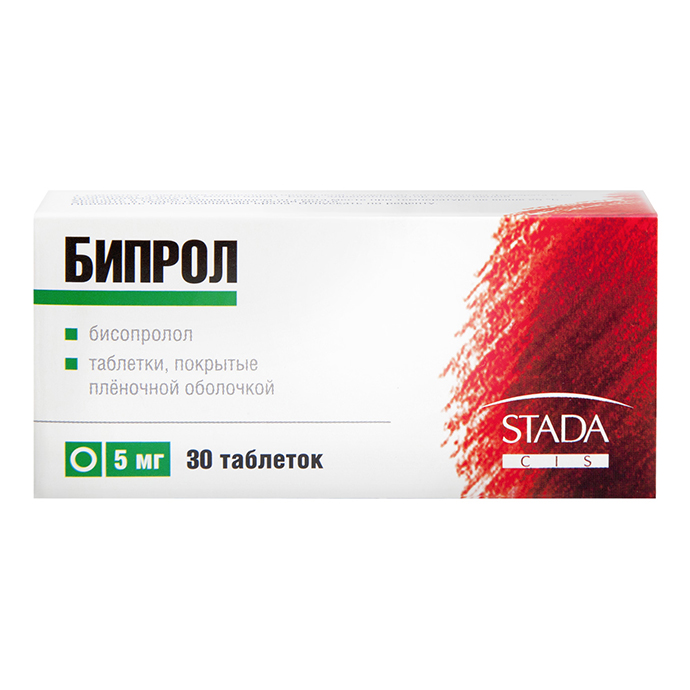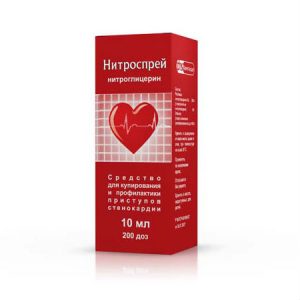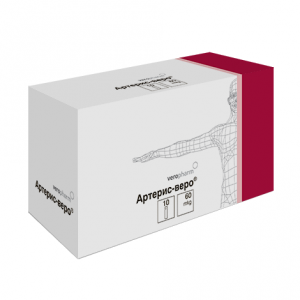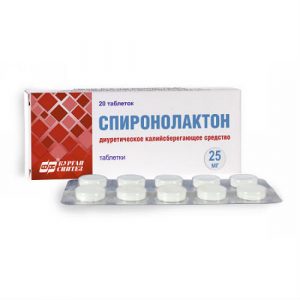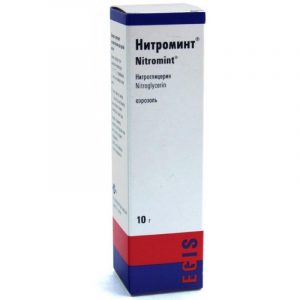Description
Latin name
Biprol
Release form
Film-coated tablets 5 mg and 10 mg.
10 tablets in blister packs of a film of polyvinyl chloride and aluminum foil.
For 3, 5 or 10 blister packs with instructions for use in a cardboard box.
Packing
30 pcs
Indications
Arterial hypertension.
Coronary heart disease: prevention of attacks of stable angina pectoris.
Contraindications
Hypersensitivity to bisoprolol, other components of the drug and other beta-blockers shock (including cardiogenic) pulmonary edema, acute heart failure or CHF in the decompensation stage, requiring inotropic therapy of AV block II-III degree, without pacemaker sinoatrial blockade sinus weakness syndrome bradycardia (heart rate less than 60 beats / min) Prinzmetal angina pectoris cardiomegaly (without signs of heart failure) severe arterial hypotension (systolic blood pressure less than 100 mmHg), especially with and myocardial infarction severe bronchial asthma and chronic obstructive pulmonary disease (COPD) in the history of simultaneous administration of flactaphenin, sultopride, monoamine oxidase inhibitors (MAO), with the exception of MAO type B, simultaneous intravenous administration of verapamil or diltiazem severe peripheral circulatory disorders, Raynaud’s pheochromocytoma syndrome (without the simultaneous use of alpha-blockers) metabolic acidosis under 18 years of age (efficacy and safety have not been established).
Lactase deficiency, lactose intolerance, lactose / isomaltose malabsorption syndrome (the drug contains lactose).
Precautions
Severe liver failure, severe renal failure (creatinine clearance less than 20 ml / min), myasthenia gravis, thyrotoxicosis, diabetes mellitus (can mask the symptoms of hypoglycemia), aggravated allergic history, AV block I degree, depression (including history ), psoriasis, bronchial asthma, COPD, peripheral circulatory disorders, strict diet.
Use during pregnancy and lactation
Use Biprol during pregnancy and lactation is possible if the benefit to the mother outweighs the risk of side effects in the fetus and the baby.
Special instructions
Treatment with the drug is usually long-term.
Before treatment, a study of the function of external respiration in patients with a history of bronchopulmonary history is recommended. Patients with bronchospastic diseases can be prescribed bisoprolol in case of intolerance and / or ineffectiveness of other antihypertensive drugs, and the dose of the drug should be strictly monitored. An overdose is dangerous for the development of bronchospasm.
Monitoring patients taking bisoprolol, should include monitoring of heart rate, blood pressure (at the beginning of treatment – daily, then 1 time in 3-4 months), electrocardiograms, plasma glucose concentration in patients with diabetes mellitus (1 time in 4-5 months). In elderly patients, it is recommended to monitor renal function (1 time in 4-5 months). The patient should be taught the method of calculating heart rate and instructed on the need for medical advice if it is reduced to less than 60 beats / min.
In approximately 20% of patients with angina pectoris, beta-blockers are ineffective. The main causes are severe coronary atherosclerosis with a low threshold of ischemia (heart rate less than 100 beats / min) and an increase in the final diastolic volume of the left ventricle, which disrupts subendocardial blood flow. In “smokers” the effectiveness of beta-blockers is lower.
Patients using contact lenses should consider that tear fluid production may be reduced during treatment.
When used in patients with pheochromocytoma, there is a risk of developing paradoxical hypertension (unless effective alpha adrenoblockade has been previously achieved).
With thyrotoxicosis, bisoprolol may mask certain clinical signs of thyrotoxicosis (eg, tachycardia). Abrupt withdrawal in patients with thyrotoxicosis is contraindicated, since it can enhance symptoms.
With diabetes, it can mask tachycardia caused by hypoglycemia. Unlike non-selective beta-blockers, practically does not enhance hypoglycemia caused by insulin and does not delay the restoration of glucose concentration in the blood to normal levels.
With the simultaneous use of clonidine, its administration can be stopped only a few days after the withdrawal of bisoprolol.
It is possible to increase the severity of the hypersensitivity reaction and the lack of effect of the usual doses of epinephrine against the background of a burdened allergic history.
If it is necessary to carry out planned surgical intervention, the drug
cancellation is carried out 48 hours before the start of general anesthesia. If the patient took the drug before surgery, he should choose a drug for general anesthesia with minimal negative inotropic effect.
Reciprocal vagus nerve activation can be eliminated by intravenous administration of atropine (1-2 mg).
Catecholamine-lowering drugs (such as reserpine) can enhance the effects of beta-blockers, so patients taking these drug combinations should be under constant medical supervision to detect arterial hypotension or bradycardia.
In the case of elderly patients with increasing bradycardia (less than 60 beats / min), arterial hypotension (systolic blood pressure below 100 mmHg), AV block, bronchospasm, ventricular arrhythmias, severe liver and kidney function impairment, it is necessary to reduce the dose or stop treatment.
Do not abruptly interrupt bisoprolol treatment because of the danger of developing severe arrhythmias and myocardial infarction. Cancellation is carried out gradually, reducing the dose for 2 weeks or more (the dose is reduced by 25% in 3-4 days).
It is recommended to discontinue therapy (with a gradual dose reduction) in case of development of depression caused by taking the drug. The drug should be discontinued before examining the blood and urine levels of catecholamines, normetanephrine and vanillin amindolic acid, the titer of antinuclear antibodies.
Effect on the ability to drive vehicles and work with mechanisms
During the treatment period, care must be taken when driving vehicles and performing other potentially dangerous activities that require increased concentration of attention and speed of psychomotor reactions.
Composition
Active ingredient bisoprolol fumarate 5,000 mg / 10, 000 mg
excipients: microcrystalline cellulose 44.500 mg / 62.400 mg ludipress LCE (lactose monohydrate 94.7-98.3%, povidone 3-4%) 40,000 mg / 38.500 mg corn starch 8,000 mg / 11,000 mg silicon colloidal dioxide 500 mg / 0,600 mg crospovidone (collidone CL) 1,000 mg / 1,250 mg magnesium stearate 1,000 mg / 1,250 mg
shell: titanium dioxide 0.287 mg / 0.430 mg macrogol (polyethylene glycol 4000) 0.287 mg / 0.430 mg hypromellose 1.320 mg / 1.968 mg talc 0.106 mg / 0.172 mg.
Dosage and administration
The drug Biprol is taken orally, in the morning, 1 time per day with a small amount of liquid, before breakfast, during or after it. Tablets should not be chewed or ground into powder. In all cases, the regimen and dose are selected by the doctor individually for each patient, in particular, taking into account the heart rate and the patient’s condition.
With arterial hypertension and coronary heart disease, the drug is prescribed 5 mg 1 time per day. If necessary, increase the dose to 10 mg once a day. In the treatment of arterial hypertension and angina pectoris, the maximum daily dose is 20 mg once a day.
For patients with severe renal impairment (creatinine clearance less than 20 ml / min) or with severe hepatic impairment, the maximum daily dose is 10 mg once a day. Increasing the dose in such patients should be carried out with extreme caution.
In elderly patients, dose adjustment is not required.
side effects
The incidence of the following side effects is listed according to the WHO classification: very often – more than 10% often – more than 1% and less than 10% infrequently – more than 0.1% and less
1% rarely – more than 0.01 % and less than 0.1% very rarely – less than 0.01%, including individual cases.
From the central and peripheral nervous system: often – fatigue, asthenia, dizziness, headache. Usually these phenomena develop at the beginning of treatment, usually expressed slightly and pass within 1-2 weeks infrequently – sleep disorders, depression rarely – nightmares, hallucinations, loss of consciousness.
From the cardiovascular system: very often – bradycardia, palpitations often – a pronounced decrease in blood pressure (especially in patients with CHF), manifestations of angiospasm (increased disorders of the peripheral circulation, sensation of coldness in the extremities (paresthesia) up to the development of complete transverse blockage and cardiac arrest), arrhythmias, aggravation of
course of CHF with the development of peripheral edema (swelling of the ankles, feet) and shortness of breath, orthostatic hypotension, chest pain .
Co storony pyschevarytelnoy system: often – nausea, vomiting, diarrhea, pain in vivo,
constipation, dry slyzystoy shell cavity PTA rarely – hepatitis, increase of activity of “hepatic” transaminases (alanine aminotransferase, aspartate aminotransferase), increase of bilirubin concentration.
From the respiratory system: infrequently – laryngeal and bronchospasm in patients with
bronchial asthma or obstructive airways disease is rare –
allergic rhinitis, nasal congestion.
From the musculoskeletal system: infrequently – muscle weakness, spasms in the gastrocnemius muscles, arthralgia.
From the organs of the senses: rarely – impaired vision, reduced tear separation (should be considered when wearing contact lenses), hearing impairment, change in taste
very rarely – dryness and tenderness of the eyes, conjunctivitis.
From the skin: rarely – increased sweating, psoriasis-like skin reactions very rarely – alopecia, exacerbation of psoriasis.
From the endocrine system: rarely – hypoglycemia.
From the genitourinary system: rarely – impaired potency, weakened libido.
From the immune system: rarely – the appearance of antinuclear antibodies with unusual clinical symptoms of lupus-like syndrome, which disappear after the end of treatment.
Allergic reactions: rarely – skin flushing, skin itching, skin rash, urticaria.
Laboratory parameters: rarely – hypertriglyceridemia very rarely – thrombocytopenia, agranulocytosis, leukopenia.
Others: rarely – cancellation syndrome (increased angina attacks, increased blood pressure).
Drug Interaction
The use of Bipromol therapy for allergens used for immunotherapy or allergen extracts for skin tests increases the risk of severe systemic allergic reactions or anaphylaxis. When co-administered with bisoprolol, iodine-containing X-ray contrast agents for intravenous administration increases the risk of anaphylactic reactions. When co-administered with bisoprolol phenytoin for I / O administration, drugs for inhalation general anesthesia (hydrocarbon derivatives) increase the severity of cardio-depressive action and the likelihood of reducing blood pressure. With the simultaneous use of bisoprolol changes the effectiveness of insulin and oral hypoglycemic drugs, masks the symptoms of developing hypoglycemia (tachycardia, increased blood pressure). When co-administered with bisoprolol, it decreases the clearance of lidocaine and xanthines (except for dipyllin) and increases their plasma concentration, especially in patients with initially increased theophylline clearance under the influence of smoking. The hypotensive effect of bisoprolol is reduced by NSAIDs (delayed Na + and blockade of the synthesis of prostaglandin by the kidneys), ACS and estrogens (delayed Na + ions). Concomitant use of cardiac glycosides, methyldopa, reserpine and guanfacin, calcium channel blockers (verapamil, diltiazem), amiodarone and other antiarrhythmic drugs increase the risk of bradycardia, AV blockade, cardiac arrest, and cardiac arrest. When co-administered with bisoprolol, nifedipine can significantly reduce blood pressure. When co-administered with bisoprolol, diuretics, clonidine, sympatholytics, hydralazine and other antihypertensive drugs can lead to an excessive decrease in blood pressure. Bisoprolol prolongs the action of non-depolarizing muscle relaxants and the anticoagulant effect of coumarins. Tri- and tetracyclic antidepressants, antipsychotic drugs (neuroleptics), ethanol, sedatives and hypnotics increase the depressant effect of bisoprolol on the CNS. Concomitant use of bisoprolol with MAO inhibitors is not recommended due to a significant increase in antihypertensive activity (the interval between MAO inhibitors and bisoprolol should be at least 14 days). When co-administered with bisoprolol, non-hydrogenated ergot alkaloids, ergotamine, increase the risk of peripheral circulation disorders. When co-administered with sulfasalazine, it increases the concentration of bisoprolol in plasma. When co-administered with rifampicin, it reduces T 1/2 of bisoprolol.
may be used. Overdose of
Symptoms: arrhythmias, ventricular extrasystole, severe bradycardia, AV block, marked decrease in blood pressure, chronic heart failure, cyanosis of the fingernails and palms of the hands, shortness of breath, convulsions, bronchospasm,
Treatment: gastric lavage, the appointment of adsorbents. If necessary, symptomatic therapy is carried out: with developed AV blockade, iv administration of atropine (1-2 mg), epinephrine or staging a temporary pacemaker with ventricular extrasystole – lidocaine (class I A drugs are not used). With a decrease in blood pressure, the patient should be in the Trendelenburg position if there are no signs of pulmonary edema, plasma-substituting solutions are administered iv in case of inefficiency – the introduction of epinephrine, dopamine, dobutamine (to maintain a chronotropic and inotropic effect and eliminate a pronounced decrease in blood pressure). With heart failure, cardiac glycosides, diuretics, glucagon for convulsions are prescribed – iv diazepam for bronchospasm – beta 2 -adrenostimulators inhaled.
Storage Conditions
In a dry, dark place at a temperature not exceeding 25 ° C.
The Expiration of
is 3 years. Do not use after the expiry date stated on the packaging.
Active ingredient
Bisoprolol
aprt aprp25
drugstores
drugstore terms of sale Prescription
